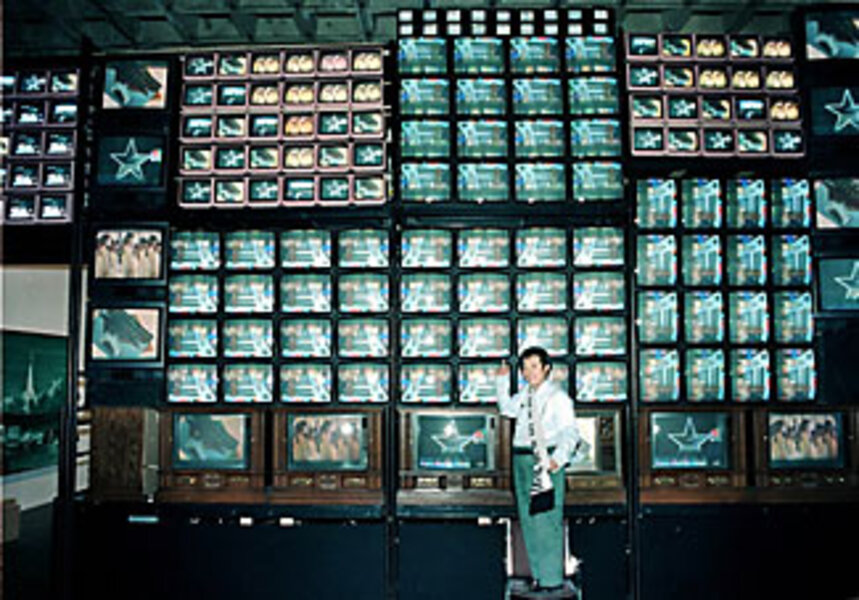Museums wrestle with preserving art that's not made to last
| Los Angeles
As part of the inaugural installation in the newly opened Broad Contemporary Art Museum at the Los Angeles County Museum of Art (LACMA), an embalmed lamb stands submerged in a vat of formaldehyde. For every installation of this Damien Hirst work, called "Away From the Flock," workers in hazmat suits must refresh the toxic fluid. Occasionally, the lamb itself must be replaced.
Half a globe away, at London's Tate Modern Museum, Colombian artist Doris Salcedo recently cracked open the concrete floor of the World War II-era building as part of her work "Shibboleth," an installation piece that required workers to partially destabilize the building's foundation during the run of the show.
These exhibits underline an important concern shared by modern artists who say they are exploring the impermanence and vulnerability of contemporary life. Even as they engage audiences on that topic, works that contain everything from chocolate syrup to exotic Amazon fruits to television tubes and radio transistors often present daunting challenges for museums, collectors, and artists themselves when it comes to preserving their art for future generations.
"There is a wonderful irony in all these things," says Lynn Zelevansky, LACMA's curator of contemporary art, "because on the one hand, many of these artists are commenting in their artwork about the transitory nature of all things, and yet they don't want their comments to be transitory or fleeting."
The issue is taking on urgency as institutions face the passing of many 20th-century artists, and consulting them about their ephemeral artwork is no longer possible.
Many artists have given considerable thought to the contradictions and challenges. Sculptor Ron Klein creates artworks from organic materials collected from around the world, often including such rare and fragile items as a flower from the Amazon or a distinctive fungus on a piece of wood.
"Art responds to its time," says Mr. Klein, who says he doesn't go out of his way to use fragile materials, but maintains that "if someone contacted me about updating a part of a work with a more permanent piece of material, I would say 'No.' I'm just an interruption in the ongoing process of deterioration."
Major institutions such as New York's Museum of Modern Art (MoMA), as well as LACMA, have developed protocols for gathering both the philosophical and practical information from artists to create support materials that will help preserve a fragile object or recreate a conceptual work.
Re-installation presents its own problems, as Ms. Zelevansky recalls from a prior stint at MoMA. Her team was reassembling a Richard Serra "scatter piece" per the artist's instructions. "It really looked not very good," she says with a laugh, and was only brought up to snuff by the appearance of the artist himself, who put on the finishing touches.
LACMA routinely has an artist fill out a detailed questionnaire. An increase in photo and video record keeping has turned such evidence into a kind of companion art form, says art historian Jennifer Way, who teaches at the College of Visual Arts and Design at the University of North Texas, Denton.
But the challenge to conservators is only going to grow, says Ms. Way, as the digital age leads to artworks with more sophisticated technological components. Beyond that, she says, as artists parallel the rest of human culture in exploring the building blocks of life and creativity, the increased presence of living components in art will present its own new set of problems.
Way points to such controversial artists as Chicagoan Eduardo Kac, creator of what he calls "biotelematic" and "transgenic" art. He helped scientists inject jellyfish genes into the fertilized egg of an albino rabbit. The resulting bunny, named "Alba," had a permanent fluorescent-green effect when viewed under certain light.
"The idea of art as a living process," says Way, "dovetails with ethical questions rampant across bio-science. What is life? When is life? What are the responsibilities when you bring the living into a gallery?" While some critics suggest that works such as Kac's cross a moral line, others say the artists are only holding up a mirror to current philosophical divides over issues such as cloning and DNA manipulation.
"What is appropriate for us to mess with?" asks Mark Terry, art professor at George Fox University in Newberg, Ore. "Fluorescent bunnies are made possible by the kind of information and technologies that came from DNA code decryption. If it's appropriate in the science lab, why not in the art lab?"
Other questions arise from the business side of the art world.
Not unreasonably, collectors have an interest in preserving value as well as artwork, says Heather Darcy Bhandari, director of Mixed Greens Gallery in New York. "Once you enter the world of commerce, you have to be willing to be concerned with the issue of maintenance," she says.
A liquid sculpture made with Gatorade, as her gallery once exhibited, requires a willingness to buy the gallons of the bottled sports drink needed to keep the fountain fresh. And what happens, she asks, if Gatorade is no longer available? Do product substitutions change the nature of the work?
High-tech components present a similar problem, says LACMA's Zelevansky. Video-art pioneer Nam June Paik left instructions to help answer those questions for future generations, says Zelevansky, but as the old Quasar TV sets in his 1968 "Video Flag Z" installation recently have begun to blow out, curators have been dismayed to discover that not only can't they find such sets, but new screens are no longer square.
The museum found a workaround, she says, by keeping the old frames and adapting other parts of the sets. Still, she says, "it's an issue on an ongoing basis."





